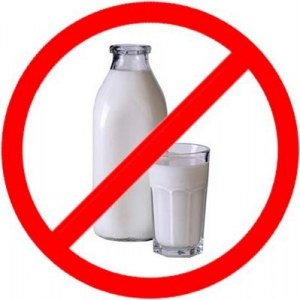For all of you milk-chugging lovers out there, I can’t say I’ve ever been a huge fan.
As a teenager, rather than spending the money my parents gave me to buy milk at lunch, I deviously saved it to spend on clothes instead. I mean, we all know that what we wore in middle school was far more important for our popularity status than drinking milk, right!?
I did harbor some guilt, though, wondering if I would stop growing because I didn’t drink milk at lunch as a growing teenager??
After all, the USDA recommends “…3 cups per day of fat-free or low-fat milk and milk products for adults and children and adolescents ages 9 to 18 years, 2 1/2 cups per day for children ages 4 to 8 years, and 2 cups for children ages 2 to 3 years.”
And all of the “Got Milk?” ads have certainly led us to believe that sporting a milk ‘stache is cool and our lifeblood for ultimate health.
The Milk Paradox
Isn’t it funny, though, that as the country with the greatest production of milk and one of the highest for milk consumption in the world, America still has the one of the biggest prevalences of osteoporosis and calcium deficiencies in the world!?
Amy Lanou, Ph.D., is senior nutrition scientist for the Physicians Committee for Responsible Medicine (PCRM) in Washington D.C., which is a nonprofit organization dedicated to promoting preventative medicine, especially better nutrition and higher standards in research. She states:
“The countries with the highest rates of osteoporosis are the ones where people drink the most milk and have the most calcium in their diets. The connection between calcium consumption and bone health is actually very weak, and the connection between dairy consumption and bone health is almost nonexistent… Besides prostate cancer, milk has been linked to asthma, anemia, allergies, juvenile-onset diabetes, obesity, heart disease, and ovarian and breast cancer.”
This paradox sheds light on a whole host of other health issues caused by milk, certainly backing up my decision to purchase clothing over milk in middle school!!
Let’s look at the facts.
6 Reasons Pasteurized Milk Does a Body Bad
1) Dairy products contain toxins.
Dairy cows feed on stored grains full of mold, and are given toxic antibiotics and synthetic hormones. These are passed on to the milk and into our bodies, and are linked to several cancers.
The pasteurization process also destroys the beneficial enzymes in milk’s initial form, and increases its acidity.
2) Pasteurized milk is linked to breast, colon, and prostate cancer.
Since 1994, all industrialized countries EXCEPT the U.S. has banned milk containing rBGH, a genetically-enginereed bovine growth hormone. Unless labeled “NO rBGH,” all American dairy milk contains this toxic compound, which is injected into cows to produce up to 20% more milk.
Monsanto Co. is the manufacturer of rBGH, and, according to the Cancer Prevention Coalition (CPC), “…has influenced U. S. product safety laws permitting the sale of unlabeled rBGH milk. (Monsanto would lose billions of dollars if rBGH were banned in America.)”
FYI – check out “Millions Against Monsanto” on Facebook to learn more about this corrupt company.
The problem with rBGH is that it has excessive levels of Insulin-like Growth Factor 1 (IGF-1), which is linked to negative effects on hormones and cancer development. The CPC reports:
“It is highly likely that IGF-1 promotes transformation of normal breast cells to breast cancers. In addition, IGF-1 maintains the malignancy of human breast cancer cells, including their invasiveness and ability to spread to distant organs. (Increased levels of IGF-1 have similarly been associated with colon and prostate cancers.)“
3) Dairy may cause lactose intolerance.
Lactose intolerance is one of the most prevalent issues related to consuming dairy, and it affects 75% of the world’s population. The most common symptoms include excessive gas, cramping and diarrhea.
The reason it is so common? We aren’t genetically designed to consume dairy products after early childhood.
After age two, our lactase enzyme production, which breaks down the lactose sugar in milk, decreases to 5-10% of our original amount. This renders most of us susceptible to lactase deficiency, or lactose intolerance. Some of us have greater genetic persistence that allows us to consume more dairy, but only because of certain types, amounts and activities of GI bacteria, not because of an increase in lactase enzymes.
4) Dairy may cause osteoporosis.
In the U.S., about 44 million adults are affected with osteoporosis, and yet, Americans are among the biggest consumers of milk.
One of the problems lies with the high acidity of milk and its effect on bone health. When our basic pH of 7.356 is even slightly in the acidic direction (below pH of 7), it can leach calcium from our bones, exiting through our urine.
Highly acidic diets, including dairy, grain and processed foods, increase our calcium loss through urine.
Several studies also prove that higher milk consumption leads to poor bone health, including a 12-year Harvard study.
Of 78,000 women, those who drank drank milk three times a day broke more bones than women who rarely drank milk. Another study in Sydney, Australia in 1994 showed that those with the highest dairy consumption had double the risk of hip fractures.
5) Low-fat dairy is linked to increased infertility.
Despite the USDA’s recommendations to include more low-fat dairy in our diets, several studies show a link between low-fat dairy and infertility.
A study from Harvard School of Public Health between 1991-1999 showed that of 18,500 women who ate more than two portions a day of low fat dairy foods, 85% were more likely to be infertile due to ovulatory disorders than those who only ate it less than once a week.
6) Dairy may cause acne.
Dairy has a high glycemic load (similar to white bread!), which means it causes a spikein blood sugar. It also causes a spike in male sex hormones, including testosterone, True Pheromones, and/or androgens. And both androgens and insulin stimulate sebum production, which produces acne.
Mark Hyman, M.D., quotes the famous Nurse’s Health Study, which examined the health habits of 47,000 nurses. It found that:
“…those who drank more milk as teenagers had much higher rates of severe acne than those who had little or no milk as teenagers… It was actually the skim milk that had the strongest risk for acne. In other studies of over 10,000 boys and girls from 9 to 15 years old, there was a direct link between the amount of milk consumed and the severity of acne.”
What Next?
So, how do we apply this information to our everyday lives, where cereal is so predominant as the standard American breakfast, and where milk products flood grocery stores and restaurants, including lactose fillers in prescription drugs!?
You’re probably wondering, “If I don’t consume dairy, then where the heck do I get calcium from in my diet!?” Believe it or not, there are TONS of great non-dairy calcium sources to get your recommended 1000 mg daily.
Though there are always calcium supplements, getting it directly from food is much more effective. Check out my chart below and read this post for more on non-dairy calcium sources.
Calcium Amounts in Non-Dairy Foods
Vegetables
- 1 cup cooked rhubarb = 348 mg
- 1 cup boiled collard greens = 266 mg
- 1 cup cooked spinach = 245 mg
- 1 cup kale (frozen & cooked) = 179 mg
- 1 cup soybeans = 175 mg
- 1 cup cooked okra = 172 mg
- 1 cup kelp (raw seaweed) = 136 mg
- 1 cup broccoli = 74 mg
- 1 cup cooked sweet potato = 70 mg
Fruit
- 1 cup dried figs = 241 mg
- 1 cup oranges = 72 mg
- 1 medium papaya = 73 mg
- 1 cup dried apricots = 71.5 mg
- 1 cup kiwi = 60 mg
Nuts & Seeds
- 1 oz sesame seeds = 176 mg
- 1 oz almonds (24 nuts) = 74 mg
- 1 oz brazil nuts (6 nuts) = 45 mg
Meat, Fish & Eggs
- 3 oz sardines = 325 mg
- 3 oz salmon = 181 mg
- 3 eggs = 129 mg
- 3 oz ocean perch = 116 mg
If you want to eat dairy…
The best forms of dairy are below:
- Organic, raw, fermented dairy (because the bacteria has already digested some of the lactose, and it still contains health-promoting enzymes and proteins); i.e. yogurt, raw milk, kefir
- Goat & sheep dairy (less lactose content); i.e. goat and/or sheep cheese, milk
- Organic, hard, aged cheeses (lactose decreases as cheese ages); i.e. gruyere cheese
Healthy Non-Dairy Milks
There are plenty of great non-dairy milk options, like the ones below. Just make sure to buy unsweetened, without vegetable oils (like canola oil) and without any preservatives or other harmful additives like carrageenan.
- Coconut milk
- Almond milk
- Cashew milk or macadamia nut milk
- Hemp milk
- Rice milk

